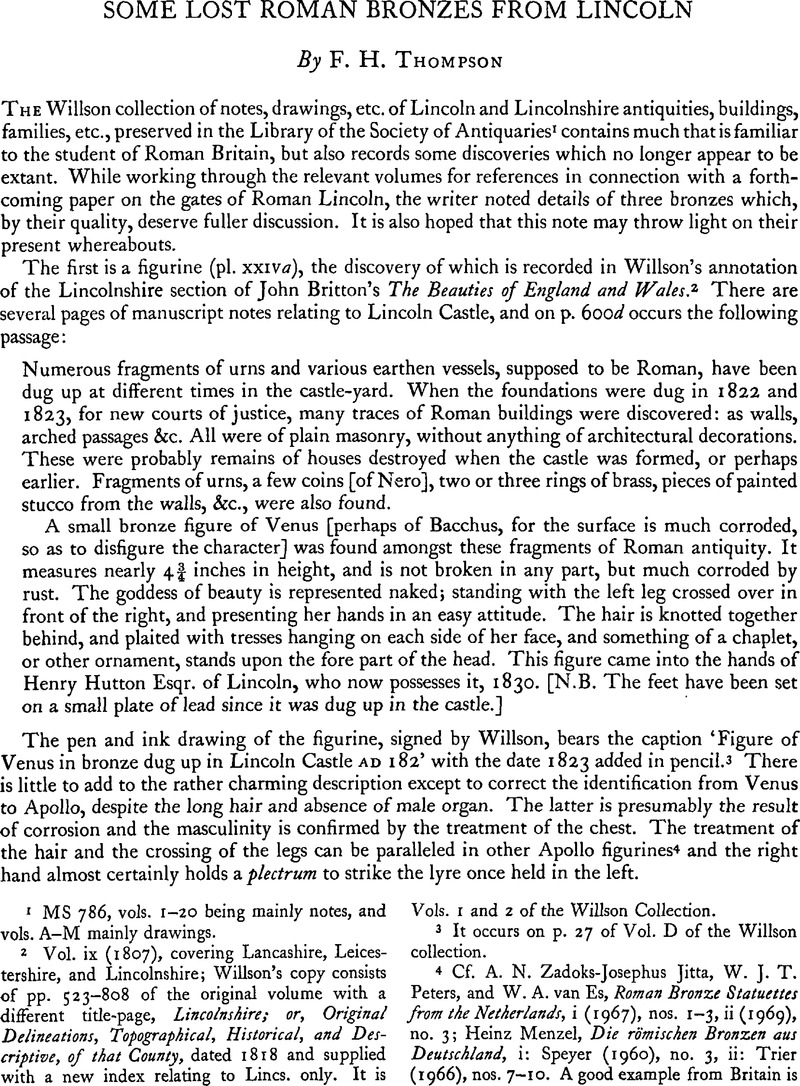Article contents
Some Lost Roman Bronzes from Lincoln
Published online by Cambridge University Press: 29 November 2011
Abstract

- Type
- Notes
- Information
- Copyright
- Copyright © The Society of Antiquaries of London 1971
References
page 100 note 1 MS 786, vols, 1–20 being mainly notes, and vols. A-M mainly drawings.
page 100 note 2 Vol. IX (1807), covering Lancashire, Leicestershire, and Lincolnshire; Willson's copy consists of pp. 523–808 of the original volume with a different title-page, Lincolnshire; or, Original Delineations, Topographical, Historical, and Descriptive, of that County, dated 1818 and supplied with a new index relating to Lines, only. It is Vols. 1 and 2 of the Willson Collection.
page 100 note 3 It occurs on p. 27 of Vol. D of the Willson collection.
page 100 note 4 Cf. Jitta, A. N. Zadoks-Josephus, Peters, W. J. T., and van Es, W. A., Roman Bronze Statuettes from the Netherlands, I (1967), nos. 1–3Google Scholar, ii (1969), no. 3; Heinz Menzel, Die römischen Bronzen aus Deutschland, i: Speyer (1960), no. 3, ii: Trier (1966), nos. 7–10. A good example from Britain is that from the Thames (pl. xxrvb), now in the British Museum (Guide to the Antiquities of Roman Britain (1958), pl. XVII, no. 17 (right); Toynbee, J. M. C., Art in Britain under the Romans (1964), p. 68).Google Scholar
page 101 note 1 Vol. 6, p. 17.
page 101 note 2 Vol. D, p. 29.
page 101 note 3 Vol. D, p. 28.
page 101 note 4 Above, n. 2.
page 101 note 5 Above, n. 3.
page 102 note 1 Discussed briefly by Liversidge, Joan, Furniture in Roman Britain (1955), pp. 34–7Google Scholar; cf. too Taylor, M. V., ‘The Sidmouth Bronze: Legionary Standard or Tripod’ (Antiq. Journ. XXIV (1944), 22–6).CrossRefGoogle Scholar For parallels, one must look abroad: cf. Jitta, Peter and van Es, op. cit., i, nos. 4, 5 (Bacchus), ii, no. 10 (Bacchus); Menzel, op. cit., ii, nos. 283, 284, 286 and 287 (boys' heads). I am indebted to Mr. K. S. Painter, Sec. S. A. for additional references, as follows: (complete stands) Cairo: Fr. W. v. Bissing, ‘Die griechisch-römischen Altertümer in Museum zu Kairo’ in Archäologischer Anzeiger (Beiblatt zum Jahrbuch des Archäologischen Instituts, 1903), 1903, p. 147, fig. 2; Hildesheim: Pernice, E., ‘Zum Hildesheimer Silberschatz II’ in Archäologischer Anzeiger, 1899, pp. 121–4Google Scholar, figs. 1–4; Turin: Atti della Società di Archeologia di Torino, III (1881), pl. xviGoogle Scholar, quoted in Perdrizet, P., Bronzes Grecs d'Egypte de la Collection Fouquet (Paris, 1911), p. 15Google Scholar, no. 13, which is itself an example of the mounts; Pompeii: Overbeck, J., Pompeii (4th edn., Leipzig, 1884), p. 429Google Scholar, fig. 230, b; (bust of Bacchus) Châlons, Marne: Froehner, W., Collection J. Greau. Les Bronzes Antiques (Paris, 1885), pp. 68–9Google Scholar, no. 325, where the description is appropriate for the Lincoln mount: ‘Buste de Bacchus adolescent, sortant d'un fleuron. Nébride sur l'epaule gauche, bandelette autour du front, pampres et grappes de raisin dans les cheveux. Le fleuron est fixé sur une petite base carrée, couronnement d'une branche de trepied. H. 0.079.’
page 102 note 2 As in the example from Trier, Menzel, op. cit., ii, no. 286.
page 102 note 3 Willson Collection, Vol. D, p. 25.
page 102 note 4 Vol. D., p. 26.
page 102 note 5 Gentleman's Magazine, N.S. XVIII (1842), 250–1 and pl. opp. 350.Google Scholar
page 102 note 6 R.I.B. 256.
page 102 note 7 Arch. Journ. CIII (1946), fig. 5, opp. p. 29.Google Scholar
page 102 note 8 Gillam, J. P., Types of Roman Coarse Pottery Vessels in Northern Britain (2nd ed., 1968), p. 8 and fig. 6.Google Scholar
page 103 note 1 Memoirs (1850), xxix, where it is said to be ‘in the form of a dragon’.
page 103 note 2 Arch. Journ. xvii (1860), 6.Google Scholar
page 103 note 3 O.R.L. xxxii, 34 and Taf. XIII, fig. 38.
page 103 note 4 It is in fact described as a ‘Wasservogel’ by Büttner, Anita in ‘Figürlich verzierte Bronzen von Kastell Zugmante’ (Saalburg Jahrbuch, XX (1962), 72), although it was missing when she made her study. I am indebted to Dr. B. Beckman of the Saalburg Museum for this reference and for the photographs.Google Scholar
page 103 note 5 London Museum Catalogue 3, London in Roman Times (1930), p. 62 and fig. 14, 4.
page 103 note 6 Germania Romana, V (1930), 10 and Taf. VIII, 5.Google Scholar
page 103 note 7 Dissertationes Pannonicae, Series 2, no. 2 (1935), p. 302, no. 4334 and pl. 1xiii, 1 (a reference kindly provided by Mr. Donald Bailey).
page 103 note 8 O.R.L. xxxii, 40.
- 3
- Cited by




